A deep dive into mortality data for young people involving guns: OGVP's 2023 report, a look at Colorado data, and a look at how that data is being skewed in its reporting.
Office of Gun Violence Prevention's 2023 report.
The Office of Gun Violence Prevention housed in CDPHE is, as part of its creating legislation, required to do yearly reports on their activities.
I like to go and pull it and give it a read to stay up on the intersection of public health and gun violence (a personal interest, an area of concern). I thought today, too, with its focus on gun violence, would be a good day to post it.
I linked to the report at bottom if you are likewise interested. I'll leave it to you to poke around in the report. If you are curious who the office is giving grants to, I would point you to p 6 for a list.
There are two things I think worth a special mention from the report, however.
The Office identified a few groups as "priority audiences", groups that they especially want to reach so that they can achieve their goals of reducing firearm injury and death (intentional and accidental). These groups are listed in screenshot 1 attached (taken from the report).
Part of this effort has been highlighted by me in previous newsletters (see, for example, my writings on getting doctors to ask screening questions about guns as part of their consultations as well as a curriculum for health care workers on ERPO's (still to be published, though it's on my list so be watching for updates). This is clearly manifest in the third bullet point.
The Office also engaged in a "listening tour", which always leaves me to wonder who got listened to. The report lists four stops and what was found which I copied and attached as screenshots 2 and 3.
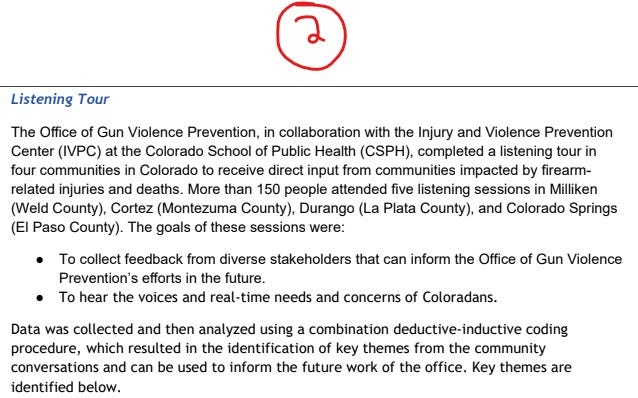

There isn't much detail on the who's and how's of the listening tour, so I wrote to the Office's press contact to ask about the stops themselves: who is invited, when the stops are announced. Specifically, I asked: "When the Office goes out around the state, where and how are their listening tours advertised? In other words, who gets told of the stop and when (in relation to the actual stop)? Are they open to the public?"
As of this writing, I've not heard back. If and when I do, I'll follow up.
The reason this is important is because who the Office is listening to (seeking out?) will greatly effect where they put their time, resources, and attention. My concern is whether or not they truly are hearing from "diverse stakeholders" or the usual groups of activists who show up to government meetings.
As for the second part (screenshot 3), don't be intimidated by their language. What they're saying is that they took comment from the meetings and squeezed them all into categories that they created. These categories being the bullet points listed. Without more detail here, I'm loathe to go beyond that.
In the meantime, if you find something you find compelling in the report, call it out in the comments (and/or let me know via message). And, if public health and guns is an interest of yours too, keep your eyes peeled for future posts on the topic.
https://drive.google.com/file/d/1xVaK0PDD5LlH9Dq9CLAynLuMLMsTiOul/view
A look at mortality data for young people involving guns.
A quick warning. This post and the one that follows it deal with gun injury, violence, suicide, and death. My discussion will be at the level of statewide data and what that tells us about statewide policy, but I want to make one thing clear at the outset.
Nothing I write here or in the following post is in any way meant to diminish anyone's death, injury, or suffering. For those affected, these things figure largely in their lives and are things numbers cannot encompass.
CDPHE maintains several databases, but the ones I link to below are for mortality statistics and emergency department visits respectively. You can search these data bases by a number of criteria: you can look at data by race, age, county, cause of injury/death. The tool is pretty straightforward to figure out.
If you want to do some exploring in the data on your own, poke around a little and you'll soon have it figured out (and if you find something noteworthy, add it to the comments or message me).
In this post, I want to look at gun-related injury and mortality for young people ages 0 to 14. I had hoped to go higher in age (see the post that follows this one), but I am constrained by the databases CDPHE maintains. In order to get fair comparisons, I also kept the settings between the injury and mortality databases as much the same as possible.
Screenshots 1 and 2 are as general as I could make them. They are all firearm injuries and deaths in the state between 2020 and 2023 respectively.
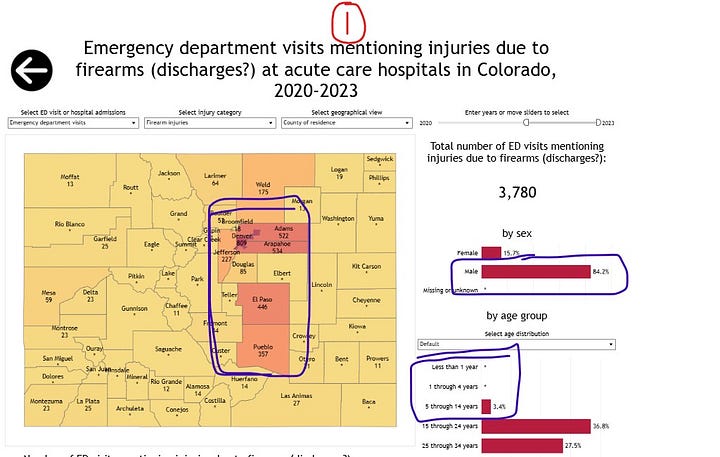

I highlighted some general patterns which you will see over and over as you dig in on this topic, and on violence in general: males suffer more injury and death (by a lot), the injuries and deaths are concentrated along the Front Range (these are absolute numbers remember so the Front Range's higher population will keep all harms concentrated there), and the group from 0 up to age 14 are thankfully nowhere near the biggest groups in causes of injury and death I consider here.
Another reasonably consistent pattern shows up, this one across time. Looking solely at mortality data for 2023 shows that, while the numbers might move, the patterns from the 2020 to 2023 time window do not (see screenshot 3 below). I did not test every single permutation, but my intuition tells me that the patterns you see in 2020 to 2023 data will be the same as those for any given single year. I therefore set the slider to 2020 to 2023 and did not move it.
Lastly, since the ED visit database does not break firearm injuries into separate subgroups, from here forward I will focus only on mortality data.
Screenshots 4 and 5 give total deaths by suicide and then deaths by suicide from firearms respectively (I highlighted the age group I am focusing on here in each).


Out of 68 total suicides, 26 were done by firearm. There is no further breakdown of method for the other 62% of suicide deaths, so I cannot give other methods.
Before moving on to homicide death, I ran a query asking for accidental deaths by firearms. That is shown in screenshot 6. There are a total of 4 deaths.
Homicide deaths in total and homicide deaths by firearm are shown in screenshots 7 and 8 attached.
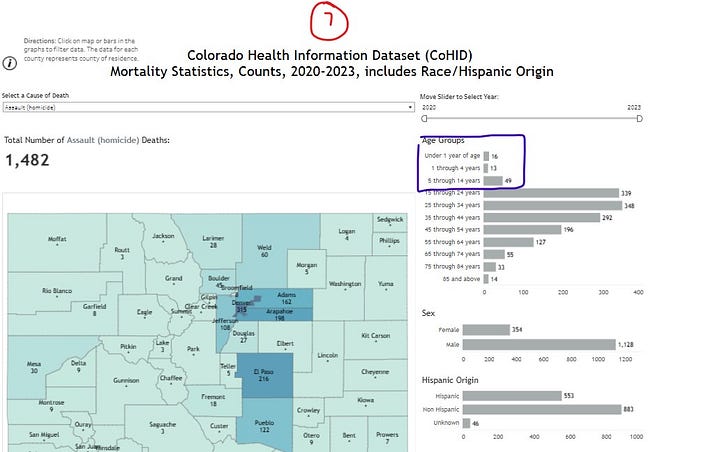

Out of 78 total deaths by homicide for the age group I am focusing on, 33 are done by firearm. That is 42% by firearm and, by comparison with screenshot 2, by far and away the largest cause of firearm related death for this age group (33 out of 71 or 46%).
Lastly, I wanted to compare these data against other causes of death. Screenshots 9 - 12 list mortality data for this age group for transport accidents, drug overdoses (of all kinds, intentional and unintentional, regardless of drug type), cancer, and influenza/pneumonia.
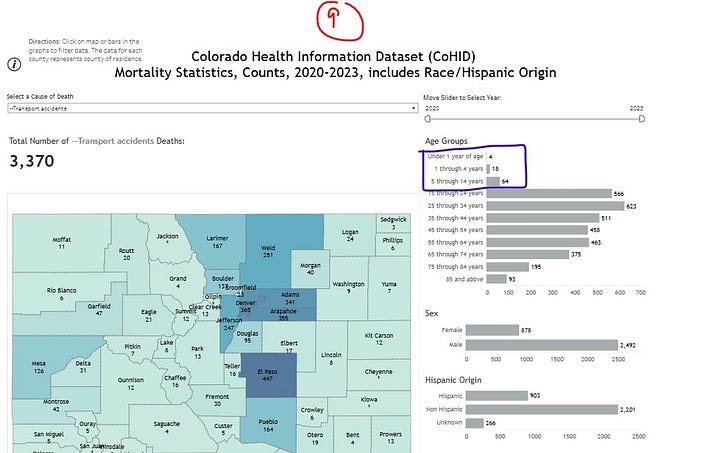


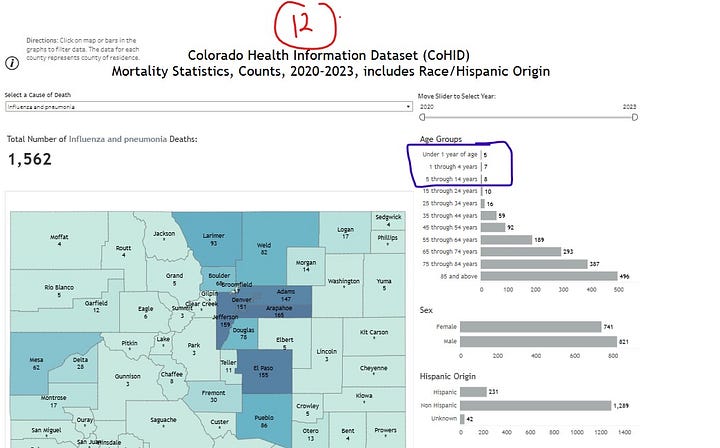
These are 86 deaths by transport, 27 by drug overdose, 58 by cancer, and 20 by influenza and pneumonia.
These are a lot of numbers and you can parse them in any number of ways, you can find any number of patterns. Here are a few that stood out to me.
You often hear the contention that guns are the major cause of death for children in Colorado. That is, in fact, the first the Google's AI told me when I asked it that question. The data here clearly do not support that for the age group I had, that is ages 0 to 14.
I also do not see a major number of young children dying by accidental gunshot injury. 4 is too many, but that is a minor fraction of total gunshot deaths in this age group, and also in comparison to the number dying by other causes (accidental and otherwise). They are also not the majority of suicide deaths for this age group. Almost 2/3rds of suicides are done with implements other than firearms.
Most startling to me are the number that are being killed by others. That number (firearms or not) is pretty high, particularly in comparison with other causes that I would expect to be much higher such as transportation accidents and drug overdoses.
I then reflect on these data in light of recent gun control moves by our state legislature. Moves to mandate safe storage of firearms, moves to prevent concealed carry in certain places, moves to ban assault weapons, moves to have credit card companies track purchases of ammunition, etc.
Compare that to things they have done to address the other issues apparent here. How much effort at curbing violence in general? How much effort to curb suicide in general? How much effort to make our roads safer? Not zero, but not the same laser focus evident on guns. This is despite insistence by some that they are guided by data and solely after reducing harm.
There are genuine cases where legislation can (without harm to constitutional rights) reduce some injury and death from firearms. To the extent that it doesn't interfere with someone's right to defend themselves, I am in support of efforts to encourage safe storage of firearms. That is an example of a low-harm policy that has the potential to reduce the number of young children dying by firearms.
At the same time, what I see when putting this data next to gun control efforts from our legislature is policy aimed at pleasing their constituents, aimed at showing themselves as "doing something", but which doesn't seem aimed at solving actual problems.
How will tracking big purchases of ammunition via credit card help the above situation? How much time is spent on guns and how much is spent on improving the deaths from moving children around from place to place?
How much effort in this area has been fruitful and how much for show?
https://cohealthviz.dphe.state.co.us/t/HealthInformaticsPublic/views/COHIDFullDeathQuery_StateDemographyPopEstimates/MortalityStatistics?iframeSizedToWindow=true&%3Aembed=y&%3AshowAppBanner=false&%3Adisplay_count=no&%3AshowVizHome=no
https://cohealthviz.dphe.state.co.us/t/PSDVIP-MHPPUBLIC/views/InjuryIndicatorsDashboard/CHACounts?%3AshowAppBanner=false&%3Adisplay_count=n&%3AshowVizHome=n&%3Aorigin=viz_share_link&%3AisGuestRedirectFromVizportal=y&%3Aembed=y
Mortality data for young males
For the last post today, I want to pick up on a tangential reference in the post prior and flesh it out a little. In the earlier post I talked about restricting my attention to children less than 14. I also talked about the claim that firearms are the leading cause of death for children, showing how this claim needs (at least) much in the way of context.
I would have gone higher, but not by much and here is why. When it comes to firearm injury and death, young, single males overwhelming skew the data. They do so for all forms of firearm related injury and death. They do so, in fact, for all forms of violent death, drug death, and, taking one example in particular, death in motor vehicles because these all relate to impulsive, risk-taking, aggressive behavior (something young males have cornered the market on).
Additionally, for whatever reason, our health department has chosen to lump young males as old as 24 with children of age 15 in terms of mortality data.
This makes it hard to address claims like the oft-repeated one above. How are we to do that for children at the start of their teens when we gum it up with older males, especially ones likely to have few to no ties to a family of their own (or the one they grew up in).
Let me demonstrate my point with some data. Screenshots 1 and 2 show the mortality data for homicides by firearm and by means other than firearms respectively for the time period from 2020 to 2023.


As I allude to above, note that the rate of deaths goes up drastically for both firearm and non-firearm homicides once you are past the age of 14 and then falls (though not as drastically) beyond that age. Note also that the spike is much more immense when it comes to firearm homicides (a 9 fold jump from children to teens and young adults) as compared to non-firearm homicides (a 2.6 fold jump).
It isn't just violence against others either. Screenshots 3 and 4 show mortality data for firearm suicides and non-firearm suicides for 2020 to 2023.
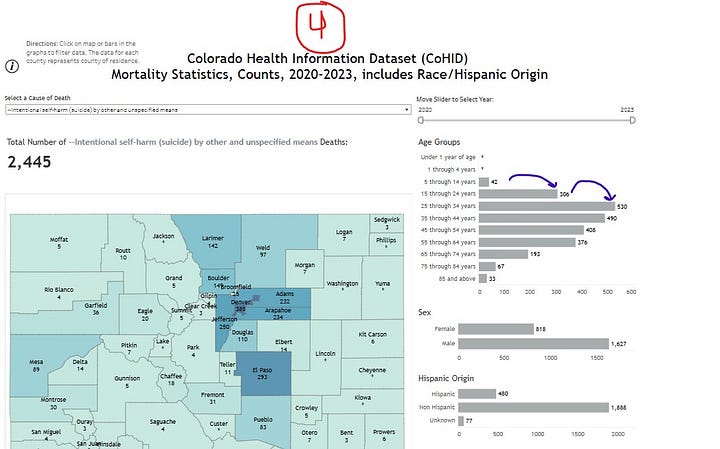

As with the homicide data, you see a spike in mortality going from young teens to the group with young adult males. Interestingly, and perhaps bursting any claim that it is access to firearms that is at play, there is a large spike going from the 25 to 34 year old brackets from the 15 to 24 bracket, this pattern persisting for non-firearm suicides too.
When the claim is made that children are dying at an alarming rate from firearms, my guess is that you picture a child (perhaps younger than 10) who is dying as opposed to a 21 year old male. This picture, the 10 year old, spurs people to action and spurs them to demand gun control as a way to protect the innocent.
Whether or not this claim is made with cynical or manipulative intent, whether it's made from ignorance, is something that only those that make it can answer. The important thing, the thing that I hope you take from this post and the one previous, is that firearm death and injury are more complicated than simple sound bites can account for. It's also highly sensitive to how you parse out the data.
So in any discussion on the issue, make sure that you understand what you're being told and where it comes from. Insist that anyone making a claim define that claim and point to its source so you can assess what you've been told.
https://cohealthviz.dphe.state.co.us/t/HealthInformaticsPublic/views/COHIDFullDeathQuery_StateDemographyPopEstimates/MortalityStatistics?iframeSizedToWindow=true&%3Aembed=y&%3AshowAppBanner=false&%3Adisplay_count=no&%3AshowVizHome=no






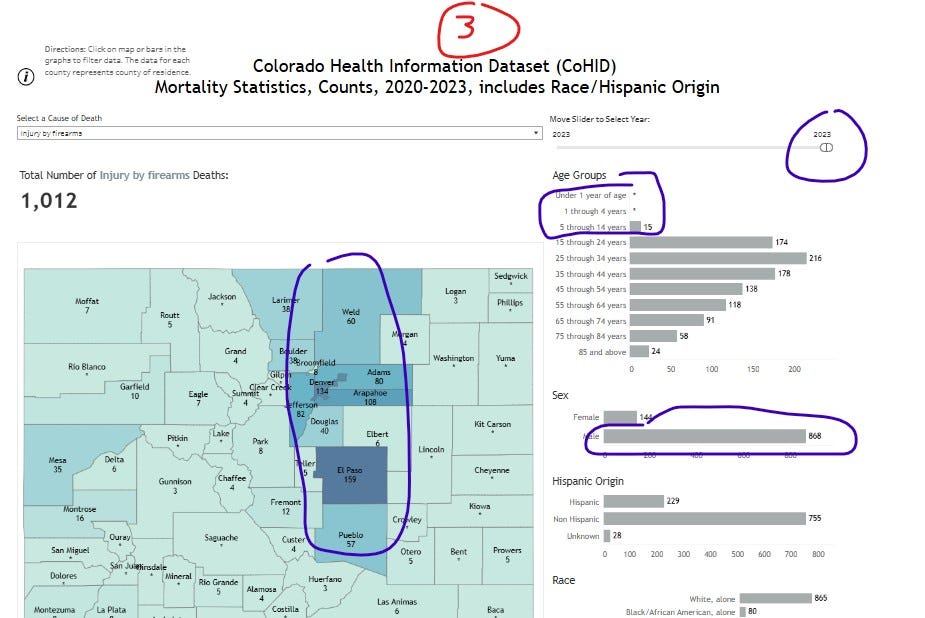


Interesting analysis of the data set. However, the real elephant in the room is rate of suicide in El Paso County!!!!!
Why isn't this a PRIORITY?